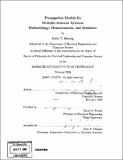Propagation models for multiple-antenna systems : methodology, measurements and statistics
Author(s)
Herring, Keith, 1981-
DownloadFull printable version (60.53Mb)
Other Contributors
Massachusetts Institute of Technology. Dept. of Electrical Engineering and Computer Science.
Advisor
David H. Satelin.
Terms of use
Metadata
Show full item recordAbstract
The trend in wireless communications is towards utilization of multiple antenna systems. While techniques such as beam-forming and spatial diversity have been implemented for some time, the emergence of Multiple-Input Multiple-Output (MIMO) communications has increased commercial interest and development in multiple-antenna technology. Given this trend it has become increasingly important that we understand the propagation characteristics of the environments where this new technology will be deployed. In particular the development of low-cost, high-performance system architectures and protocols is largely dependent on the accuracy of available channel models for approximating realized propagation behavior. The first contribution of this thesis is a methodology for the modeling of wireless propagation in multiple antenna systems. Specifically we consider the problem of propagation modeling from the perspective of the protocol designer and system engineer. By defining the wireless channel as the complex narrow-band channel response h e C between two devices, we characterize the important degrees of freedom associated with the channel by modeling it as a function of its path-loss, multipath/frequency, time stability, spatial, and polarization characteristics. We then motivate this model by presenting a general set of design decisions that depend on these parameters such as network density, channel allocation, and channel-state information (CSI) update rate. Lastly we provide a parametrization of the environment into measurable factors that can be used to predict channel behavior including link-length, Line-Of-Sight (LOS), link topology (e.g. air-to-ground), building density, and other physical parameters. The second contribution of this thesis is the experimental analysis and development of this modeling space. (cont) Specifically we have gathered a large database of real wireless channel data from a diverse set of propagation environments. A mobile channel-data collection system was built for obtaining the required data which includes an eight-channel software receiver and a collection of WiFi channel sounders. The software receiver synchronously samples the 20-MHz band centered at 2.4 GHz from eight configurable antennas. Measurements have been carried out for both air-to-ground and ground-to-ground links for distances ranging from tens of meters to several kilometers throughout the city of Cambridge, MA. Here we have developed a collection of models for predicting channel behavior, including a model for estimating the path-loss coefficient a in street environments that utilizes two physical parameters: P1 = percentage of building gaps averaged over each side of the street, P2= percentage of the street length that has a building gap on at least one side of the street. Results show a linear increase in a of 0.53 and 0.32 per 10% increase in P1 and P2, respectively, with RMS errors of 0.47 and 0.27 a for a's between 2 and 5. Experiments indicate a 10dB performance advantage in estimating path-loss with this multi-factor model over the optimal linear estimator (upper-bound empirical model) for link lengths as short as 100 meters. In contrast, air-to-ground links have been shown to exhibit log-normal fading with an average attenuation of a ; 2 and standard deviation of 8dB. Additionally we provide exhaustive evidence that the small-scale fading behavior (frequency domain) of both Non-Line-Of-Sight (NLOS) air-to-ground and ground-to-ground links as short as tens of meters is Rayleigh distributed. More specifically, fading distributions across a diverse set of environments and link lengths have been shown to have Rician K-factors smaller than 1, suggesting robust performance of the Rayleigh model. (cont) A model is also presented that defines a stochastic distribution for the delay-spread of the channel as a function of the link-length (do), multipath component (MPC) decay-rate ( ... attenuation per unit delay ... ), and MPC arrival-rate (q = MPCs per unit delay ... periments support the use of this model over a spectrum of link-lengths (50m-700m) and indicate a dense arrival-rate (q) (on the order of 1 MPC) in ground-to-ground links. In this range the frequency structure of the channel is insensitive to q, which reduces the modeling complexity to a single unknown parameter, P. We provide estimators for 3 over a variety of environment types that have been shown to closely replicate the fade width distribution in these environments. The observed time-coherence length (tc) of MPCs tend to be either less than 300ms (high-frequency) or 5 seconds and longer (low-frequency), resulting in a Rician-like distribution for fading in the time domain. We show that the time characteristics of the channel are accurately modeled as the superposition of two independent circularly symmetric complex gaussian random variables corresponding to the channel response due to a set of stable and unstable MPCs. We observe the S-factor, defined as the ratio of average power in stable to unstable MPCs (distinct from the Rician K-factor), which ranges between 0-30dB depending on environment and link length, and can be estimated with an rms error of 3dB in both ground-to-ground and air-to-ground link regimes. Experiments show improved performance of this model over the Rician fading model which has been shown to underestimate high fade events (tails) in the time domain, corresponding to cases where the stable MPCs destructively combine to form a null. Additionally, the Kronecker MIMO channel model is shown to predict channel capacity (of a 7x7 system) with an rms error of 1.7 ... (at 20dB SNR) over a diverse set of observed outdoor environments. (cont) Experiments indicate a 3dB performance advantage in this prediction when applied to environments that are not dominated by single-bounce propagation paths (Single-bounce: 2.1 ... rms, Multi-bounce: 1 ... rms).
Description
Thesis (Ph. D.)--Massachusetts Institute of Technology, Dept. of Electrical Engineering and Computer Science, 2008. Includes bibliographical references (leaves 219-223).
Date issued
2008Department
Massachusetts Institute of Technology. Department of Electrical Engineering and Computer SciencePublisher
Massachusetts Institute of Technology
Keywords
Electrical Engineering and Computer Science.